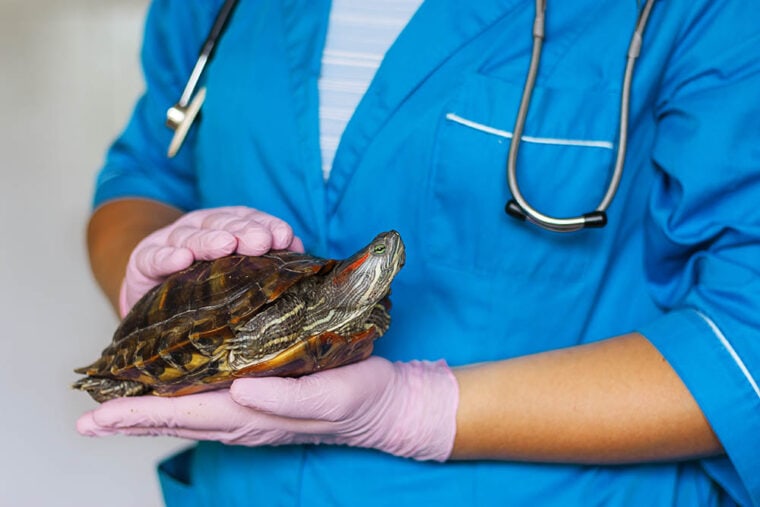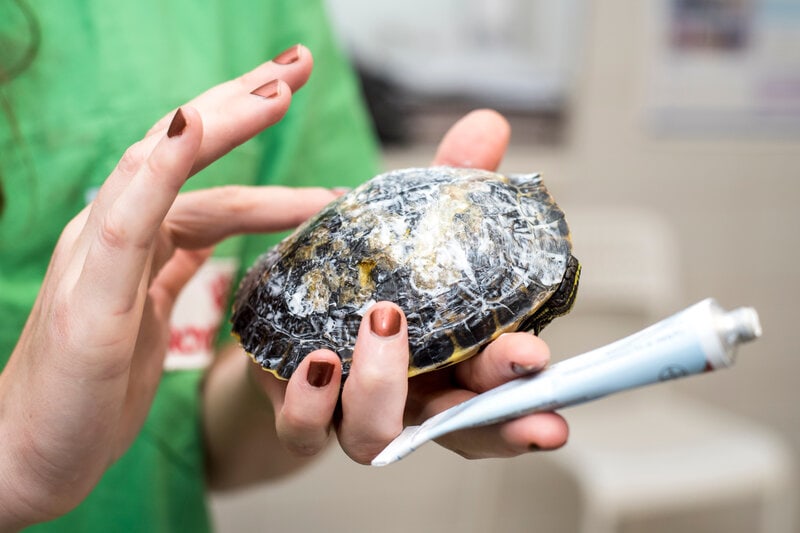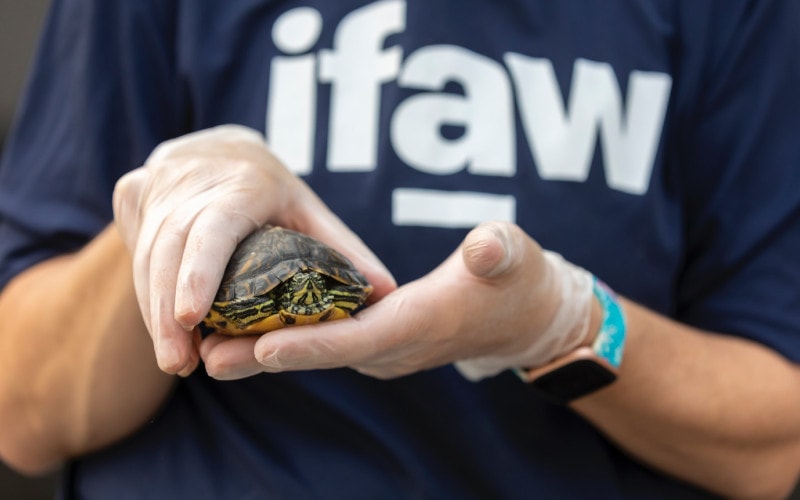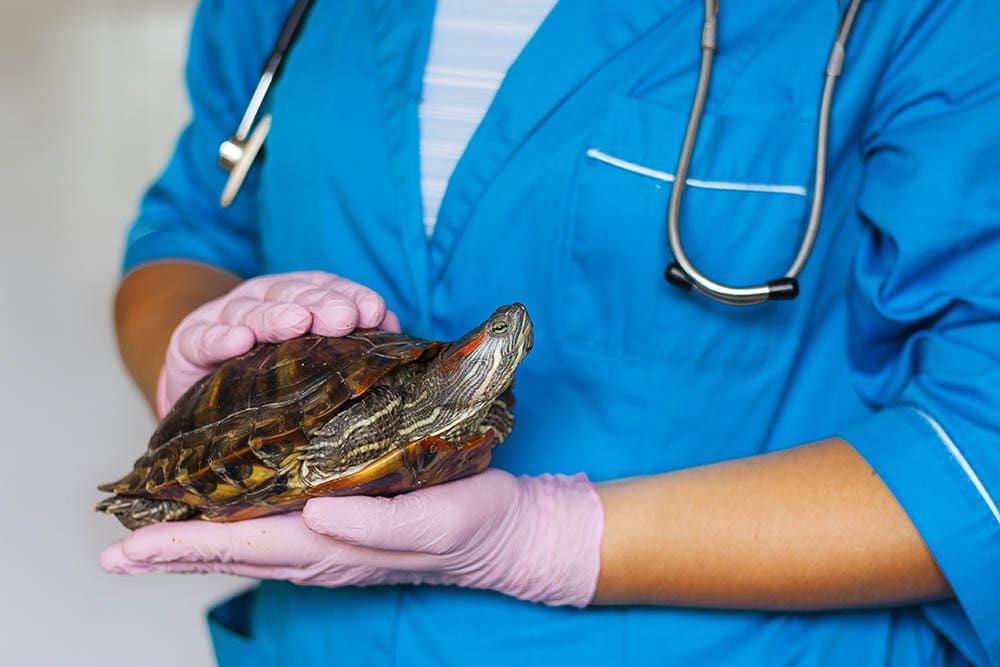
Aquatic turtles are very popular pet reptiles because they are very interesting to observe, are typically hardy, have long lifespans, and don’t require the same type of social needs as other types of pets. Like any other pet though, they can suffer from various health conditions that owners need to be aware of.
There are many different species of aquatic turtles in the pet trade, so it’s important to be knowledgeable about your specific pet. In this article, we will further discuss the most common diseases observed in aquatic turtles, the clinical signs to look out for, and what you can expect if your turtle is suspected to have one of these conditions.
The 7 Most 7 Common Diseases in Aquatic Turtles
1. Vitamin A Deficiency

Vitamin A deficiency, or hypovitaminosis A, is the most common nutritional deficiency seen in aquatic turtles. Vitamin A is essential for proper skin development and organ function. If the turtle is not getting enough vitamin A in their diet, it can lead to some very serious health issues to the skin, mucous membranes, eyes, kidneys, respiratory system, and more.
Causes
This condition occurs as a result of too little vitamin A in the turtle’s diet. This could be because the turtle is not being fed the appropriate diet for their species or the diet they are being offered is poor quality.
Diagnosis
To diagnose a vitamin A deficiency, a veterinarian will go over the turtle’s dietary regime and clinical signs and perform a thorough physical exam. They may order blood tests or even take a sample from any abnormal tissue.
Treatment
If an aquatic turtle has been diagnosed with a vitamin A deficiency, it will need a change in diet to ensure they begin getting enough Vitamin A in its regular diet. The veterinarian may also prescribe vitamin A supplements to provide injectable vitamin A.
Treatment must be done under the supervision of a veterinarian, as too much vitamin A can lead to vitamin A toxicity. If the turtle is experiencing an underlying bacterial or fungal infection related to the deficiency, treatment can include topical and/or systemic antibiotics or antifungal medications.
2. Respiratory Disease

Respiratory infections are typically common in pet reptiles and are usually a sign of improper nutrition or husbandry. These infections are most often caused by bacteria and may not be noticeable at first but can quickly develop into pneumonia.
Causes
The root cause of respiratory infections is often bacteria and many aquatic turtles with respiratory tract infections also have underlying vitamin A deficiency that will require prompt treatment.
Diagnosis
If a respiratory infection is suspected, the veterinarian will go over the turtle’s clinical signs and perform a physical examination. They may recommend taking X-rays and/or running blood tests and cultures to determine the root cause of the infection so that proper treatment can be administered.
Treatment
Treatment of respiratory infections involves antibiotics that may be given orally, by injection, or via nasal drops. The veterinarian will also work to figure out the root cause of the respiratory infection, such as vitamin A deficiency, so that this underlying cause can be treated.
3. Shell Infection

Shell infections, which are sometimes referred to as shell rot or SCUD (Septicemic Cutaneous Ulcerative Disease) are the result of either bacteria, fungi, or parasitic infection. They are often a secondary result of trauma, burns, or bites to the shell. Shell infections may be shallow but can also penetrate deeply, resulting in pitting of the shell and ulcers, and may extend to the bone that lies below.
Causes
While shell rot can be caused by a variety of bacteria, fungi, or even parasites, the most common reason that pet aquatic turtles develop the condition is due to poor husbandry. The water in the tank can be a breeding ground for bacteria if not cleaned regularly and properly filtered. It can also be related to water quality, incorrect temperature and/or humidity levels, or damage to the shell.
Diagnosis
A veterinarian will diagnose shell rot by performing a physical exam and possibly taking a sample of the affected area, bloodwork, and even radiographs. The sample of the affected area is taken to help them identify the specific type of bacteria, fungi, or parasite so that proper treatment can be administered.
Treatment
Treatment for this condition is known for being a bit challenging but it generally involves a thorough cleansing of the shell and appropriate medications after the underlying cause has been identified.
4. Abscesses

Abscesses are infected, pus-filled swollen areas of tissue on the body. They take on a tumor-like appearance and are full of pus that is typically similar in appearance to cottage cheese. Abscesses in aquatic turtles are often in the ears (on the side of the head) or behind the eyes.
Causes
Abscesses more often due to underlying vitamin A deficiency. They can also occur due to suppression of the immune system, which can be caused by poor living conditions or nutritional deficiencies. Occasionally, abscesses may appear after a traumatic injury or a viral infection.
Diagnosis
The veterinarian will perform a physical exam and consider the turtle’s medical history and care regimen.
Treatment
Abscesses are treated surgically by opening up the affected area and allowing the pus to be drained. Once it is clear of pus, the tissue will be flushed and thoroughly cleaned with a medicated solution. A sample will be taken so the type of bacteria can be identified and proper medication can be administered. Topical, oral, or even injectable antibiotics may be administered. If the underlying cause is determined to be nutritional deficiency or poor husbandry, these issues will need to be addressed to prevent them from recurring.
5. Parasites

Gastrointestinal parasites are fairly common in pet turtles. Parasitic infections often do not cause any clinical signs and are detected during a routine exam that involves a fecal test. A severe parasitic infection could lead to diarrhea, weight loss, and lead to more serious health issues if left untreated.
Causes
Various parasites such as nematodes, tapeworms, flukes, flagellates, and more can affect pet turtles. They can easily be passed from turtle to turtle and can also be the result of an unclean living environment.
Diagnosis
Aquatic turtles don’t usually give any telltale signs of parasitic infection other than diarrhea or weight loss if it has become more severe. These are often diagnosed by a routine fecal examination performed by the veterinarian.
Treatment
Gastrointestinal parasites are treated with antiparasitic or deworming medications. The type of parasite will be identified by microscopic analysis of the feces and will help the veterinarian determine which type of medication is necessary.
6. Intestinal Obstruction

An intestinal obstruction occurs when there is a blockage in the digestive system that prevents food or liquid from passing through the intestines.
Causes
Intestinal obstructions in aquatic turtles most often occur when they eat the gravel at the bottom of their tank. Experts are not quite sure of the root cause of this behavior, but it is hypothesized that it could be a natural behavior to aid digestion, a way of obtaining minerals, or the result of boredom or hunger.
Diagnosis
If a turtle is suspected to have an intestinal obstruction, the veterinarian will go over the clinical signs that have been observed and will ask if this behavior is common in the specific turtle. X-rays will be conducted to confirm an obstruction and to see the severity.
Treatment
Depending on the position and the size of the gravel, the veterinarian will either administer a type of syrup to induce vomiting or may advise that surgical intervention is needed to manually remove the stones.
7. Shell Fracture

A shell fracture is a very serious condition because the shell is what protects the turtle’s internal organs. It is the result of blunt force trauma that was capable of causing a crack in the shell or a piece of the shell to come off.
Causes
Shell fractures are the result of trauma and can easily occur if the pet turtle has been dropped by the handler, fallen off a surface after they’ve escaped its enclosure, dog bites, and more.
Diagnosis
Shell fractures are typically visible to the naked eye, but a veterinarian will need to perform X-rays to determine the severity of the fracture to see how deeply the turtle has been affected.
Treatment
Treatment will need to be performed by an experienced veterinarian. Turtles can typically recover nicely if the fracture isn’t too severe, and they are given the proper care. Even severe damage may sometimes be repaired using medical-grade plastics, epoxy cement, and proper care instructions. This will be at the discretion of the veterinarian.
Tips for Keeping Your Aquatic Turtle Healthy
Provide the Proper Habitat
Aquatic turtles are going to require a sturdy, secure enclosure that has two-thirds of it dedicated to water and the remaining space used as a dry area where the turtle can escape the water and bask under the proper lighting. The proper size of an enclosure will be dependent on the specific species, age, sex, and how many turtles will inhabit it.
Have an Excellent Water Filtration System
The water quality within your turtle’s tank is extremely important, which is why you should invest in a top-of-the-line filtration system to keep the water as clean as possible. The filter should match or exceed the maximum amount of water your habitat can hold. Partial and full water changes will be necessary in addition to a proper filtration system.
Maintain Proper Temperature and Basking Area
Aquatic turtles are going to require a dry basking area that features a UVA/UVB light and proper temperature controls, keeping a steady basking temperature of 89 to 95 degrees Fahrenheit. The basking light should be available for up to 14 hours during the spring and summer and up to 12 hours during the fall and winter. Water temperature will also need to be regulated and remain between 72- and 80 degrees Fahrenheit.

Feed a Proper Diet
You need to ensure your aquatic turtle is fed an appropriate diet for their species and age. This requires intensive research into the species that you plan on keeping and understanding their dietary requirements throughout the different stages of their life. Nutritional deficiencies can lead to vitamin A deficiency, metabolic bone disease, and many other health conditions. If you ever have questions about your turtle’s dietary needs, reach out to your veterinarian for assistance.
Provide Enrichment
Wild turtles have plenty of enrichment in their natural environment, so it’s important to feature different types of enrichment within their captive habitat. Do some research on the different aquatic plants you can keep in your turtle’s tank, just make sure to keep safety in mind and ensure there would be no chance that your turtle could become entangled.
Keep Up with Regular Cleaning
An unsanitary living environment is a common cause of many diseases in captive reptiles. The tank will need to be cleaned at least once a week and complete cleaning that involves replacing all the water and cleaning the filter should take place every two to three weeks. Having an aquatic pet involves some serious upkeep because the water can become a breeding ground for bacteria.
Conclusion
Like any pet, aquatic turtles can suffer from a variety of health conditions that will prompt your attention. Most of these conditions are related to either nutritional deficiencies or poor husbandry, making them highly preventable with proper diet and care. Always reach out to your veterinarian if you have any concerns about your turtle’s health or how to properly care for them.
See Also:
- How Often Do Turtles Poop? Vet-Reviewed Facts & FAQ
- Do Tortoises & Turtles Fart? Vet-Reviewed Facts & FAQ
- 4 Common Turtle Eye Infections: Signs, Treatment, & FAQ (Vet Answer)
Featured Image Credit: ALIAKSANDR PALCHEUSKI, Shutterstock







